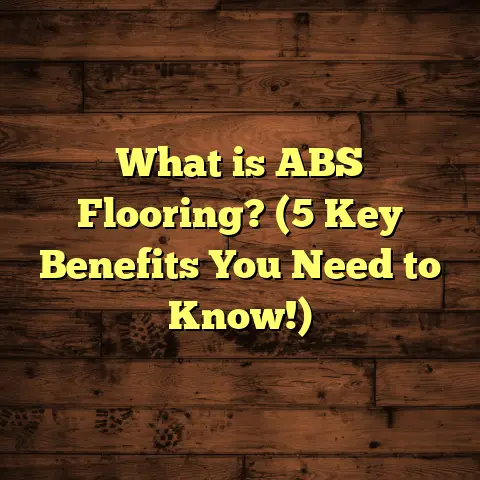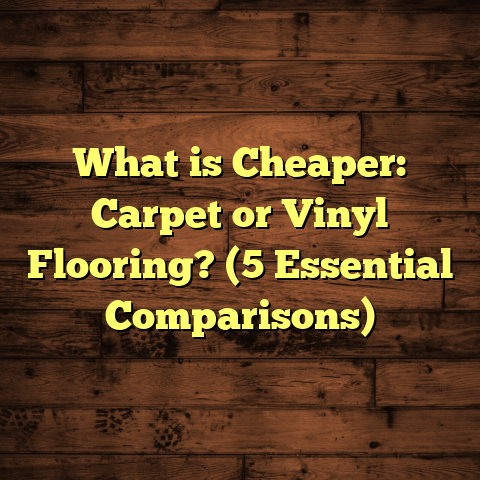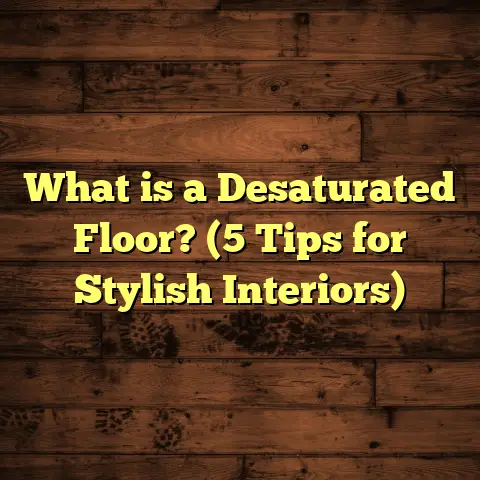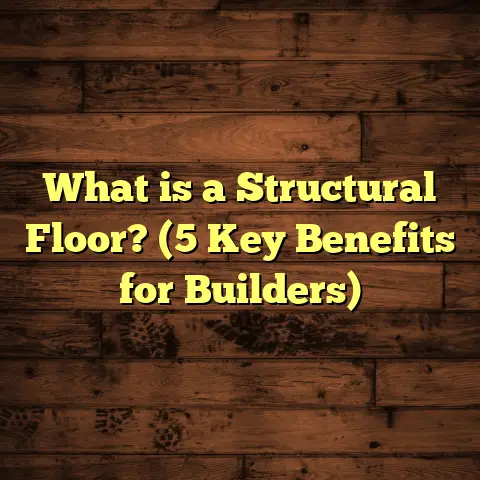What is a Floating Floor? (5 Key Benefits for Your Home)
Layering is a crucial concept in flooring that most people overlook. When I first started working with floors, I realized how much the layers beneath the surface impact everything—from comfort to durability to appearance. Take any floor you walk on, and you’ll find it’s made up of multiple layers, each serving a purpose. Understanding these layers will give you a clearer picture of why certain floors perform better and what options fit your home best. One type of floor that highlights the idea of layering perfectly is the floating floor. If you’re wondering what it is and why it’s gaining popularity, stick with me as I explain everything in detail.
What Is a Floating Floor?
A floating floor is a flooring system where the floorboards are not attached directly to the subfloor beneath them. Instead, the boards are connected to each other and rest on top of an underlayment layer, effectively “floating” above the subfloor. This installation method contrasts with traditional flooring, where boards are nailed or glued down.
The term “floating” comes from the fact that the floor isn’t fixed permanently to the base. Instead, it’s held together by the interlocking mechanism of the planks themselves. Think of it as a giant jigsaw puzzle laid out over a soft mat. The pieces lock together to form a solid surface, but they can also move slightly with changes in temperature or humidity.
Floating floors are usually made from materials such as laminate, engineered hardwood, and luxury vinyl plank (LVP). These materials come designed with tongue-and-groove systems or click-lock edges that make assembly straightforward.
Why Does This Matter?
When I first encountered floating floors, I was amazed at how this simple concept could solve so many problems homeowners face. Traditional hardwood floors require professional installation, nails or glue, and can be expensive and time-consuming to install. Floating floors reduce these barriers significantly.
Also, because they aren’t fixed down, floating floors can expand and contract without cracking or warping—a common issue with solid wood floors. This flexibility makes floating floors well-suited for environments where temperature and moisture fluctuate.
Layer Composition of a Floating Floor
Understanding the layers gives you an idea of how floating floors function:
- Top Layer (Wear Layer): This is the visible surface that protects against scratches, dents, and stains. In laminate floors, it’s usually a tough resin-coated film. In engineered hardwood, it’s a real wood veneer sealed with polyurethane. LVP has a durable vinyl wear layer.
- Core Layer: Provides stability and structure. Laminate uses high-density fiberboard (HDF), engineered hardwood has plywood or fiberboard cores, while vinyl planks use composite materials.
- Underlayment: A cushioning layer beneath the core that reduces noise, absorbs shocks, and acts as a moisture barrier.
- Subfloor (Existing Floor): The base layer, often concrete or plywood, that supports everything above.
Having these layers work together is what makes floating floors practical and comfortable.
Five Key Benefits of Floating Floors for Your Home
I’ve installed many types of flooring over the years, but floating floors always stand out for their balance of ease and performance. Here are five benefits I’ve seen first-hand that make floating floors worth considering.
1. Easy and Quick Installation
Installation speed is one of my favorite things about floating floors. When I installed laminate flooring in my own home office, I was done in under eight hours for a 300-square-foot room. No special tools were needed beyond a saw for cutting planks, spacers to maintain expansion gaps, and a tapping block to lock pieces together.
The process involves laying down an underlayment on a clean subfloor and then clicking or locking each plank together side-by-side and end-to-end. Since there’s no need for glue or nails, cleanup is minimal.
Here’s why this matters:
- DIY Friendly: You don’t have to hire an expensive contractor unless you want to.
- Less Mess: No fumes from adhesives or dust from nails.
- Speed: Faster installation means less disruption to your daily routine.
Home improvement polls show that over 60% of DIY renovators choose floating flooring options specifically because they’re manageable without professional help.
2. Cost-Effective Flooring Solution
Budgeting is always on my mind when helping clients select flooring. Floating floors typically cost less upfront and during installation compared to traditional hardwood or stone tiles.
Based on recent market data (2025), here’s a breakdown:
| Flooring Type | Material Cost per sq.ft. | Installation Cost per sq.ft. | Total Cost per sq.ft. |
|---|---|---|---|
| Solid Hardwood | $6 – $12 | $5 – $10 | $11 – $22 |
| Engineered Hardwood | $5 – $9 | $4 – $8 | $9 – $17 |
| Laminate (Floating) | $1.50 – $4 | $1.50 – $4 | $3 – $8 |
| Luxury Vinyl Plank | $2 – $6 | $2 – $5 | $4 – $11 |
The savings come from both material costs and installation labor. Traditional hardwood has to be nailed down slowly and carefully; floating floors snap together quickly.
Over a 1,000-square-foot room, choosing floating laminate instead of solid hardwood could save you between $8,000 and $14,000.
3. Versatile Installation Options
Floating floors aren’t picky about where they go. One thing I’ve learned after installing floors in several homes is how much time and money floating floors save when dealing with tricky subfloors.
They can be installed over:
- Concrete slabs
- Existing vinyl or tile floors (if flat)
- Plywood
- Radiant heated floors (with proper underlayment)
In contrast, traditional hardwood usually requires removing old flooring or preparing subfloors extensively.
For example, I once worked on a basement renovation where removing old tile would have been costly and messy. We simply cleaned the existing floor thoroughly, added an underlayment designed for moisture protection, and floated vinyl planks over it. The result was beautiful and functional, all without demolition.
4. Comfort Underfoot and Noise Reduction
Walking barefoot on floating floors feels noticeably softer compared to solid hardwood or tiles because of the cushioning effect of the underlayment.
I remember friends telling me their old hardwood floors felt cold and hard in winter, but after switching to floating vinyl planks with foam underlayment, their feet stayed warmer and their rooms quieter.
Scientifically speaking, studies have shown that quality underlayments can reduce impact noise transmission by 20-30 decibels—enough to make a big difference in multi-story homes or apartments.
5. Simple Maintenance and Easy Repairs
Floors take abuse—kids running around, pets scratching, heavy furniture moving—and no floor is immune to damage over time.
The beauty of floating floors is how easy it is to replace damaged sections without uprooting the entire floor.
In one project, a friend had a water spill that damaged several laminate planks in her kitchen area. Instead of pulling up everything, she replaced just those planks by unlocking them carefully and snapping new ones in place.
Daily maintenance involves basic sweeping or vacuuming to remove dirt and occasional damp mopping with manufacturer-approved cleaners.
Diving Deeper: Materials Used in Floating Floors
Not all floating floors are created equal because different materials offer different benefits depending on your needs.
Laminate Flooring
Laminate is probably the most common floating floor type because it’s affordable and versatile. It consists of four layers:
- Wear Layer: Transparent protective coating resistant to scratches.
- Design Layer: High-resolution photographic image mimicking wood or stone.
- Core Layer: High-density fiberboard providing stability.
- Backing Layer: Balances moisture resistance and support.
Laminate is great for high-traffic areas but can be prone to water damage if moisture seeps through seams.
Engineered Hardwood
Engineered hardwood uses real wood veneer on top of plywood or fiberboard cores.
- Offers authentic wood look
- More dimensionally stable than solid hardwood
- Can be floated or glued down depending on product
It tends to be pricier than laminate but gives you real wood aesthetics with easier installation.
Luxury Vinyl Plank (LVP)
LVP has exploded in popularity due to its durability and waterproof nature.
- Made from multiple layers including vinyl wear layer
- Waterproof and scratch-resistant
- Mimics wood or stone textures
- Comfortable underfoot due to flexibility
Ideal for kitchens, bathrooms, basements—places where moisture is a concern.
Real Data: Comparing Durability and Lifespan
I often get asked how long floating floors last versus traditional flooring methods. Here’s what I found based on industry data and personal experience:
| Flooring Type | Expected Lifespan | Durability Notes |
|---|---|---|
| Solid Hardwood | 30-100 years | Can be sanded/refinished multiple times |
| Engineered Hardwood | 20-40 years | Limited refinishing potential |
| Laminate | 10-25 years | Wear layer protects but can’t be refinished |
| Luxury Vinyl Plank | 15-30 years | Waterproof; resistant to stains & dents |
For families with kids or pets who want durability without fuss, LVP and laminate are excellent choices.
A Case Study: Floating Floor Success in Real Homes
I want to share an experience from a client’s home renovation that really highlights the benefits discussed so far.
The project involved replacing old carpet in a 600-square-foot living room with floating engineered hardwood flooring. The homeowners wanted:
- A warm wood look
- A solution compatible with radiant heating
- Easy installation with minimal downtime
We selected an engineered hardwood product specifically designed for floating installation over radiant heat systems.
Results:
- Installation was completed in two days by two installers.
- The radiant heating worked efficiently through the floor.
- The homeowners reported improved comfort levels compared to carpet.
- No issues with expansion or contraction after six months.
- They appreciated how easy it was to clean compared to carpet.
This case convinced me that floating engineered hardwood can combine luxury look with convenience.
Addressing Common Questions About Floating Floors
I’ve answered many questions from clients and friends about floating floors over time; here are some you might have too:
Can floating floors be installed over concrete?
Yes! As long as the concrete is dry, level, and clean, you can lay an appropriate vapor barrier underlayment and float your floor right over it.
Are floating floors good for basements?
Definitely—especially vinyl plank options that are waterproof. Engineered hardwood can work if moisture levels are controlled properly.
Do floating floors make noise?
Some cheaper products may produce hollow sounds during walking if underlayment isn’t sufficient. Choosing quality underlayment reduces this problem significantly.
Can I install floating floors myself?
Yes! Many homeowners do this successfully with basic tools and patience.
Tips From My Experience for Installing Floating Floors
Over years of installing various floors, I’ve picked up some practical tips that make floating flooring projects smoother:
- Always acclimate your flooring materials for at least 48 hours in the room where they’ll be installed to prevent expansion/shrinkage issues later.
- Use spacers around walls to maintain recommended expansion gaps—usually around ¼ inch—to allow natural movement.
- Invest in quality underlayment tailored for your flooring type; it improves comfort and noise reduction.
- Check subfloor flatness before installation—a variance greater than 3/16 inch over 10 feet can cause problems.
- Keep extra planks handy for future repairs; matching batches can vary slightly in color.
- Follow manufacturer guidelines closely for cutting, locking mechanisms, and cleaning instructions.
I always tell clients that taking these small steps upfront saves headaches down the road.
Environmental Impact and Sustainability Considerations
Sustainability matters more today than ever before when choosing home materials. Floating floors have some interesting points here:
- Engineered hardwood uses less solid wood than traditional hardwood because only the surface veneer is real wood.
- Laminate flooring often contains recycled materials in its core layers.
- Vinyl plank flooring, while durable and low-maintenance, still relies on petroleum-based products; however, many brands now offer eco-friendly options with lower VOC emissions.
When selecting flooring for an environmentally conscious home, check for certifications like FloorScore or GREENGUARD which indicate low emissions and better indoor air quality.
How Floating Floors Compare With Other Flooring Types
To help clarify where floating floors fit among other popular options:
| Feature | Floating Floors | Solid Hardwood | Tile | Carpet |
|---|---|---|---|---|
| Installation Difficulty | Low-Medium | High | Medium | Low |
| Cost | Moderate | High | Moderate | Low |
| Maintenance | Easy | Moderate | Moderate | High |
| Moisture Resistance | Moderate (LVP high) | Low | High | Low |
| Comfort | High | Moderate | Low | High |
| Repairability | Easy | Difficult | Difficult | Moderate |
Floating floors strike a balance between comfort, cost, ease of installation, and durability that appeals to many homeowners today.
Final Thoughts: Is a Floating Floor Right for You?
If you’ve read this far, you probably already see that floating floors offer unique advantages making them suitable for many homes:
- They’re straightforward enough for DIYers yet stylish enough for design-conscious buyers.
- Their layered construction provides comfort without sacrificing durability.
- They save time and money during installation.
- They adapt well to different subfloor types.
- And they’re easy to maintain over time.
Whether you’re renovating your basement on a budget or upgrading your living room with engineered hardwood aesthetics without breaking the bank, floating floors deserve serious consideration.
If you have questions about specific materials or need help planning your installation, feel free to ask! I enjoy chatting about flooring almost as much as installing it—and I’m here to help make your home comfortable and beautiful one layer at a time.





